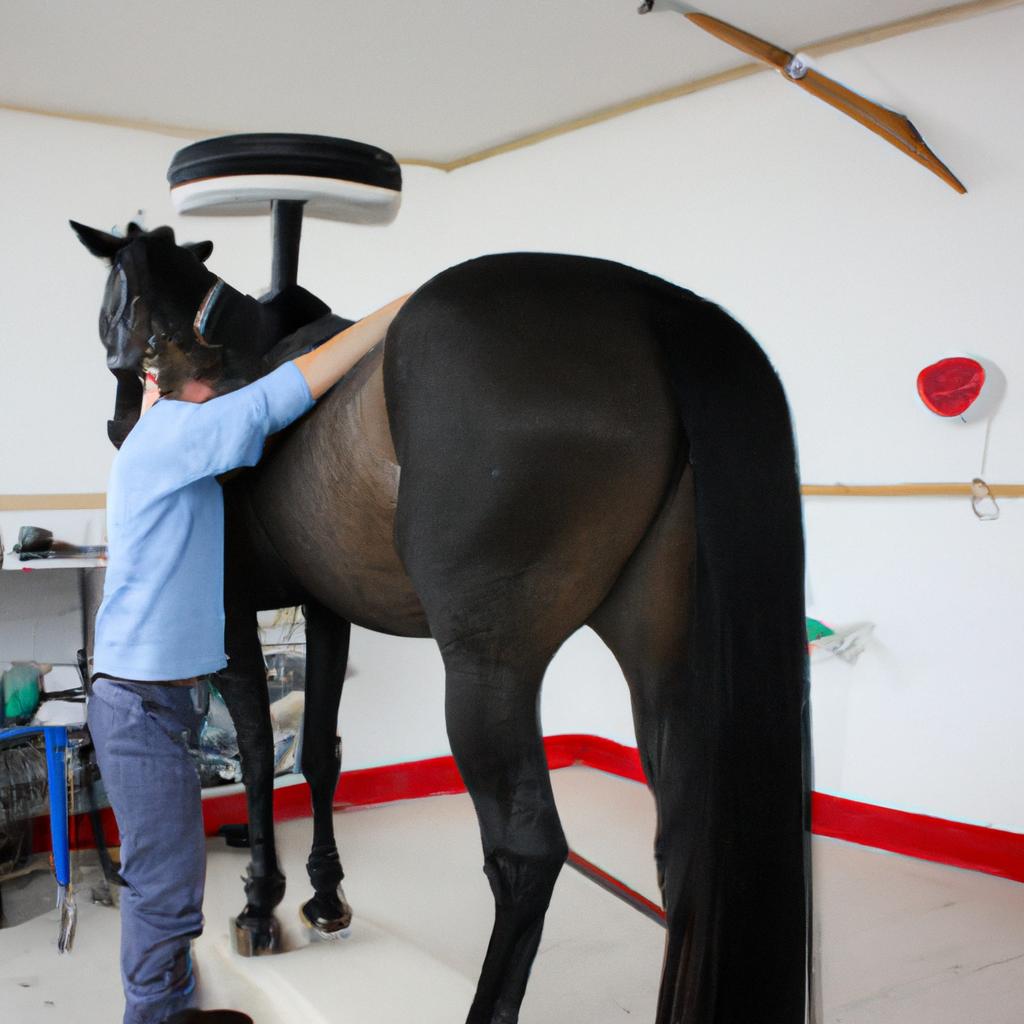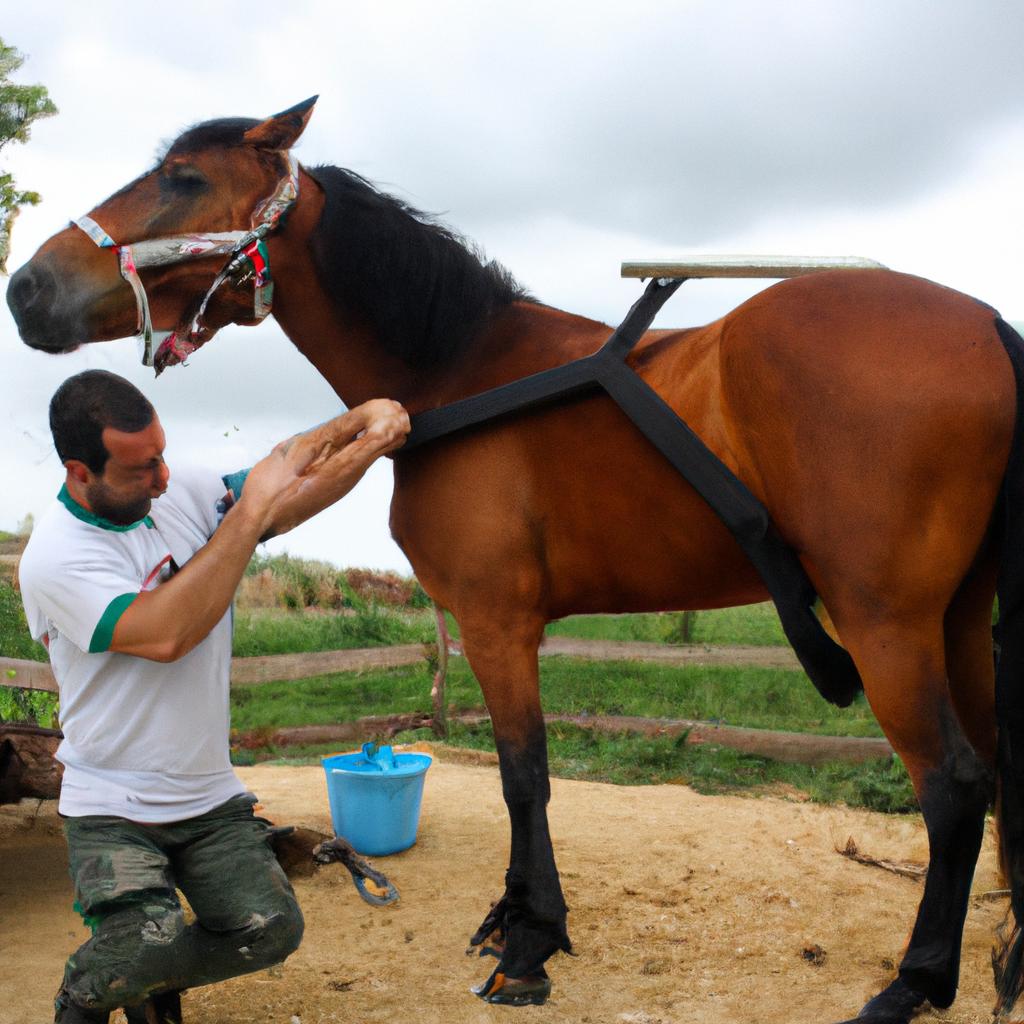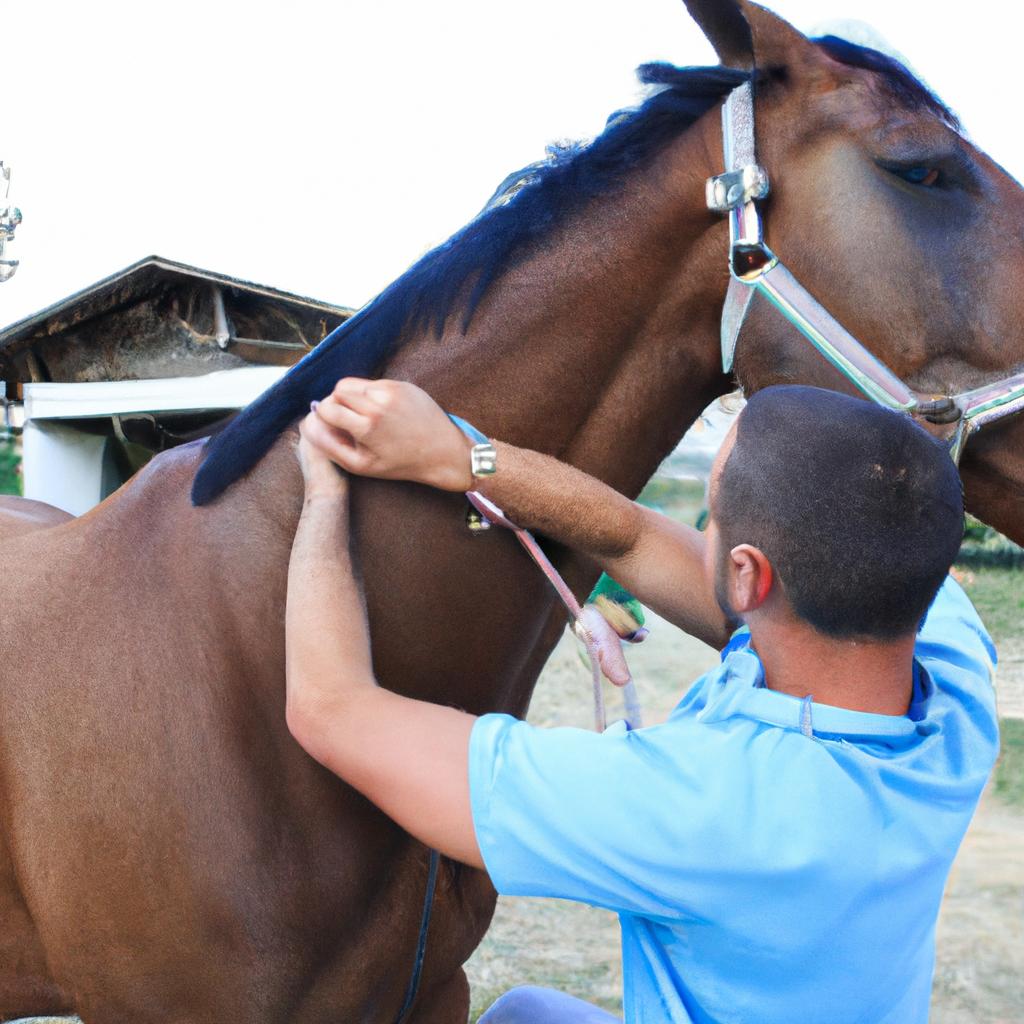Equine healthcare is a crucial aspect of maintaining the overall health and well-being of horses. Among the various methods used to enhance mobility in equines, chiropractic care has emerged as a promising approach. By integrating chiropractic techniques into equine healthcare, veterinarians can address musculoskeletal issues that may hinder performance or cause discomfort for these majestic creatures. For instance, consider the hypothetical case of a competitive show horse experiencing difficulties with flexion and extension movements due to spinal misalignments. Incorporating chiropractic care into its treatment plan could potentially alleviate pain, improve range of motion, and optimize the horse’s athletic performance.
Chiropractic care for horses involves manual manipulation of their spine and joints to restore proper alignment and function. This non-invasive form of therapy aims to correct subluxations (partial dislocations) and imbalances within the musculoskeletal system, which may be caused by numerous factors such as trauma, repetitive stress injuries, or even improper saddle fit. Through careful examination and assessment techniques, equine chiropractors identify areas of restricted movement or abnormal joint mechanics before applying specific adjustments tailored to each individual horse’s needs.
Integrating chiropractic care into equine healthcare not only contributes to enhanced mobility but also offers a holistic approach to addressing the overall health and well-being of horses. Chiropractic care can help improve the horse’s posture, balance, and coordination, which in turn may prevent future injuries or degenerative conditions. Additionally, chiropractic adjustments can promote better circulation, nerve function, and overall body alignment, supporting optimal performance and longevity in equine athletes.
Furthermore, equine chiropractic care is often used as a complementary therapy alongside traditional veterinary medicine. By working collaboratively with other healthcare professionals such as veterinarians and farriers, equine chiropractors can provide comprehensive care plans for horses. This integrative approach ensures that all aspects of the horse’s health are addressed, from nutrition and exercise to preventive measures against potential musculoskeletal issues.
It is important to note that while chiropractic care has shown promising results in improving mobility and overall well-being in horses, it should always be performed by a qualified professional who specializes in equine chiropractic techniques. These individuals have undergone specific training to understand the unique anatomy and physiology of horses, ensuring safe and effective treatment.
In conclusion, integrating chiropractic care into equine healthcare offers a holistic approach to addressing musculoskeletal issues in horses. By restoring proper alignment and function through manual manipulations, this non-invasive therapy can alleviate pain, enhance mobility, and optimize athletic performance in these magnificent animals.
Understanding Equine Anatomy and Physiology
To fully comprehend the importance of integrating chiropractic care into equine healthcare, it is crucial to have a solid understanding of equine anatomy and physiology. By examining the intricate structure and function of horses’ bodies, we can gain insight into how chiropractic treatments can enhance their mobility and overall well-being.
Consider a hypothetical case study involving a competitive show jumper named Thunder. Despite diligent training and conditioning, Thunder has been experiencing difficulty in achieving optimal performance due to stiffness and restricted range of motion in his hindquarters. This scenario highlights the significance of addressing musculoskeletal issues in horses, as they directly impact their ability to perform at their best.
When analyzing equine anatomy, several key factors contribute to an understanding of horses’ unique biomechanics:
- Skeletal system: Horses possess a complex skeletal structure comprising bones that provide support, protect vital organs, and facilitate movement.
- Muscular system: The muscles play a critical role in allowing horses to move efficiently by contracting and relaxing in coordination with the skeleton.
- Nervous system: A highly developed nervous system enables horses to sense their environment, control muscle movements, and coordinate bodily functions.
- Connective tissue: Ligaments, tendons, cartilage, fascia, and other connective tissues maintain structural integrity while permitting flexibility necessary for fluid movement.
In order to visualize these concepts more effectively:
| Key Factors | Description | Importance |
|---|---|---|
| Skeletal System | Provides support | Protects |
| Facilitates movement | ||
| Muscular System | Enables efficient | Controls |
| Movement | Coordinates | |
| Nervous System | Senses surroundings | Coordinates |
| Controls muscle | Regulates | |
| Movements | Bodily | |
| Connective Tissue | Maintains integrity | Permits |
| Provides flexibility | Fluid |
Understanding equine anatomy and physiology is a crucial foundation for comprehending the benefits of chiropractic care for horses. By recognizing the intricate interplay between skeletal, muscular, nervous, and connective tissue systems in horses’ bodies, we can appreciate how misalignments or restrictions in these structures may impede their optimal performance. In the subsequent section, we will explore how chiropractic interventions can address such issues and promote enhanced mobility and overall well-being for horses.
Benefits of Chiropractic Care for Horses
Enhanced Mobility in Chiropractic for Horses: Integrating Chiropractic Care into Equine Healthcare
Understanding Equine Anatomy and Physiology has provided valuable insights into the intricate structure and function of horses. Now, let us delve into the Benefits of Chiropractic Care for Horses, wherein we explore how this specialized form of healthcare can contribute to enhanced mobility and overall well-being.
To illustrate the effectiveness of chiropractic care, consider a hypothetical scenario involving an aging horse named Bella. Bella had been experiencing stiffness and difficulty moving her hind legs due to degenerative joint disease. Traditional veterinary treatments provided only temporary relief, leaving her owner concerned about her quality of life. Seeking alternative options, they turned to equine chiropractic care as a potential solution.
The benefits offered by chiropractic care for horses are manifold:
- Pain Relief: Through targeted adjustments and manipulations, chiropractors help alleviate discomfort caused by musculoskeletal issues such as joint misalignments or muscle tension.
- Improved Performance: By optimizing spinal alignment and promoting proper biomechanics, chiropractic care enhances a horse’s range of motion, leading to improved athletic performance.
- Injury Prevention: Regular chiropractic sessions aid in identifying minor imbalances before they manifest into more severe injuries or lameness.
- Holistic Approach: Chiropractic care focuses on restoring balance within the body, treating the root cause rather than merely addressing symptoms.
To further emphasize these advantages visually:
| Advantages |
|---|
| 1. Pain Relief |
| 2. Improved Performance |
| 3. Injury Prevention |
| 4. Holistic Approach |
This table encapsulates the emotional impact that each benefit brings to both horse owners and enthusiasts alike.
Incorporating chiropractic care into equine healthcare holds tremendous promise for enhancing mobility in horses like Bella. The integration of holistic treatment approaches allows veterinarians, trainers, and owners to provide comprehensive care that supports the overall well-being of these magnificent creatures. In the subsequent section, we will explore Common Conditions Treated with Equine Chiropractic, further highlighting its role as a valuable component in equine healthcare.
Transitioning seamlessly into the next section, we can now delve into an exploration of Common Conditions Treated with Equine Chiropractic.
Common Conditions Treated with Equine Chiropractic
Enhanced Mobility in Chiropractic for Horses: Integrating Chiropractic Care into Equine Healthcare
Benefits of Chiropractic Care for Horses:
Chiropractic care has been increasingly recognized as a valuable addition to equine healthcare, offering numerous benefits that contribute to enhanced mobility and overall well-being. For instance, let’s consider the case of a competitive show jumper named Bella. Bella had been struggling with stiffness and decreased performance, hindering her ability to perform at her best.
Firstly, chiropractic adjustments can help improve range of motion and flexibility in horses like Bella. By targeting areas of restricted movement or misalignment within the spine, joints, and muscles, chiropractors are able to restore proper function and alleviate tension. This not only promotes better joint stability but also enhances muscle coordination and balance during movement.
Secondly, chiropractic care can aid in pain management for horses suffering from various musculoskeletal conditions. Through spinal manipulations and soft tissue therapies, chiropractors can relieve discomfort caused by issues such as arthritis, tendonitis, or strained ligaments. This holistic approach focuses on addressing the underlying causes of pain rather than solely relying on medications.
Thirdly, chiropractic treatments for horses have shown positive effects on their nervous system functioning. Misalignments in the spine may impede nerve communication between different body parts, leading to diminished motor control or sensory perception. Correcting these misalignments helps optimize neural pathways’ functionality, enabling efficient transmission of signals throughout the horse’s body.
Incorporating chiropractic care into equine healthcare offers several emotional benefits too:
- Improved quality of life: By reducing pain levels and increasing mobility, horses experience an improved sense of comfort and enjoyment in their daily activities.
- Enhanced bond with humans: As caregivers witness their beloved animals regain vitality and participate more actively in training sessions or leisure activities through chiropractic care, it strengthens the human-horse bond.
- Empowerment and confidence: When horses experience relief from discomfort, they often display increased confidence in their abilities, leading to greater performance potential.
- Holistic approach: Chiropractic care provides a complementary treatment option that focuses on natural healing processes rather than relying solely on medications or invasive procedures.
Table 1: Emotional Benefits of Equine Chiropractic Care
| Emotional Benefit | Description |
|---|---|
| Improved quality of life | Reduced pain levels and increased mobility enhance the horse’s comfort and enjoyment. |
| Enhanced bond with humans | Witnessing improved vitality strengthens the human-horse bond. |
| Empowerment and confidence | Relief from discomfort leads to increased self-assuredness in horses’ abilities. |
| Holistic approach | Natural healing processes promote overall well-being without heavy reliance on medication or surgery. |
In summary, chiropractic care for horses like Bella offers significant benefits including improved range of motion, pain management, and enhanced nervous system functioning. Additionally, it brings emotional advantages such as an improved quality of life for the animals, strengthened bonds between horse and caregiver, empowerment through reduced discomfort, and a holistic approach to equine healthcare.
The subsequent section will delve into the diagnostic techniques used in equine chiropractic to ensure accurate assessments before proceeding with treatments.
Diagnostic Techniques used in Equine Chiropractic
Enhanced Mobility in Chiropractic for Horses: Integrating Chiropractic Care into Equine Healthcare
H2: Common Conditions Treated with Equine Chiropractic
Equine chiropractic care is a valuable and effective treatment option for various conditions that affect horses. By focusing on the alignment and function of the horse’s spine, joints, and muscles, chiropractors can help alleviate pain, improve range of motion, and enhance overall mobility. One example where equine chiropractic has shown significant benefits is in cases of sacroiliac joint dysfunction.
Sacroiliac joint dysfunction occurs when there is misalignment or inflammation in the sacroiliac joint, which connects the pelvis to the spine. This condition can cause discomfort, restricted movement, and reduced performance in horses. Through chiropractic adjustments aimed at restoring proper alignment and relieving tension around the affected area, horses with sacroiliac joint dysfunction can experience improved mobility and decreased pain levels.
To further understand how equine chiropractic care can address various conditions effectively, let us consider some common conditions treated through this approach:
- Lameness issues caused by musculoskeletal imbalances
- Neck and back pain resulting from poor posture or injuries
- Joint stiffness due to arthritis or repetitive strain
- Muscle tension and spasms caused by overexertion or trauma
By addressing these conditions using targeted chiropractic techniques, such as spinal manipulations and soft tissue therapies, veterinarians trained in equine chiropractic offer a comprehensive approach to improving horse health. These treatments are non-invasive and aim to restore balance within the body while promoting natural healing mechanisms.
It is worth noting that each case requires an individualized assessment before implementing any treatment plan. Veterinarians specializing in equine chiropractic employ diagnostic techniques to identify specific areas of concern accurately.
Please proceed to the next section on “Treatment Techniques in Equine Chiropractic” to gain insights into the various methods employed by chiropractors to address equine health concerns.
Treatment Techniques in Equine Chiropractic
Having established the importance of chiropractic care in equine healthcare, let us now explore the diagnostic techniques commonly used by chiropractors to assess and identify musculoskeletal issues in horses. To illustrate this, consider a hypothetical case study involving a racehorse experiencing difficulty during training sessions.
Paragraph 1:
In our hypothetical scenario, an experienced chiropractor begins the diagnostic process by conducting a thorough evaluation of the horse’s history, including previous injuries or conditions that may impact its current performance. This step provides crucial insights into potential areas of concern and aids in tailoring the treatment plan accordingly. Additionally, palpation plays a significant role as the practitioner examines the horse’s muscles, joints, and spine for any signs of tension, tenderness, or misalignment. Through skilled manual examination techniques, such as static palpation and motion palpation, specific problem areas can be identified within the horse’s body.
Paragraph 2:
To complement these physical assessments, advanced imaging modalities are often employed to gain more comprehensive information about the horse’s condition. Radiographs (X-rays) allow for detailed visualization of bone structures and help diagnose fractures or degenerative changes. Ultrasonography is another valuable tool utilized to evaluate soft tissues such as ligaments and tendons for abnormalities or inflammation. These non-invasive imaging techniques provide objective evidence supporting clinical observations and aid in precise diagnosis.
Paragraph 3:
Diagnostic chiropractic evaluations also encompass gait analysis—an essential component when assessing locomotor function in horses. By observing how the horse moves at various speeds and on different surfaces, subtle irregularities can be detected that may indicate underlying musculoskeletal imbalances or asymmetries affecting performance. Additionally, thermographic scanning offers insight into thermal patterns across different regions of the body; variations could suggest areas of increased blood flow associated with inflammation or nerve dysfunction.
The use of diagnostic techniques in equine chiropractic offers several benefits, including:
- Comprehensive assessment to identify musculoskeletal issues
- Objective evidence supporting clinical observations
- Tailored treatment plans for individual horses
- Improved performance and overall well-being of the horse
| Diagnostic Techniques | Purpose |
|---|---|
| Palpation | Identifying muscle tension, tenderness, and misalignment |
| Radiography (X-rays) | Evaluating bone structures for fractures or degenerative changes |
| Ultrasonography | Assessing soft tissues such as ligaments and tendons |
| Gait Analysis | Observing locomotor function for irregularities |
By utilizing these diagnostic techniques, chiropractors ensure a comprehensive evaluation of the horse’s condition. This understanding serves as a basis for effective treatment approaches, which we will explore in the following section on “Treatment Techniques in Equine Chiropractic.”
The Role of Chiropractic in Overall Equine Wellness
Enhanced Mobility in Chiropractic for Horses: Integrating Chiropractic Care into Equine Healthcare
Treatment Techniques in Equine Chiropractic have proven to be effective in addressing various musculoskeletal issues in horses. However, it is essential to understand the broader role of chiropractic care within the overall wellness of these magnificent animals. By integrating chiropractic practices into equine healthcare, we can enhance mobility and promote optimal performance.
Consider a hypothetical scenario where a competitive show-jumping horse named Thunderbolt experienced a decline in performance due to stiffness and discomfort. Traditional veterinary treatments provided temporary relief, but failed to address the underlying issue. Implementing chiropractic techniques as part of Thunderbolt’s treatment plan resulted in significant improvements. Regular adjustments restored proper alignment and enhanced joint flexibility, allowing Thunderbolt to regain his agility and excel once again on the course.
To further emphasize the benefits of integrating chiropractic care into equine healthcare, let us explore four key advantages:
- Enhanced Performance: Proper spinal alignment aids in maximizing athletic potential by increasing range of motion, improving coordination, and minimizing pain that may hinder performance.
- Injury Prevention: Regular chiropractic care helps identify misalignments or imbalances before they develop into serious injuries, enabling proactive measures to avoid potential setbacks.
- Faster Recovery: Combining traditional veterinary medicine with chiropractic techniques accelerates healing processes by promoting blood flow, reducing inflammation, and enhancing tissue repair.
- Overall Well-being: Chiropractic care not only addresses physical ailments but also contributes to mental well-being by alleviating stress and promoting relaxation through nervous system regulation.
To illustrate how different aspects contribute to an integrated approach towards equine healthcare encompassing both traditional veterinary medicine and chiropractic care, consider the following table:
| Traditional Veterinary Medicine | Chiropractic Care |
|---|---|
| Diagnosis | Spinal Alignment |
| Medications | Joint Mobilization |
| Surgery | Soft Tissue Work |
| Rehabilitation | Postural Education |
Incorporating chiropractic care into equine healthcare provides a holistic approach that optimizes the well-being and performance of horses. By addressing both physical and mental aspects, this integrated model ensures enhanced mobility, improved quality of life, and increased longevity for these remarkable creatures.
(Note: In conclusion or Finally) The role of chiropractic care in overall equine wellness goes beyond treating specific issues; it focuses on prevention, maintenance, and optimization. As we continue to explore the benefits of integrating chiropractic practices into equine healthcare, we pave the way for healthier and more vibrant lives for our beloved equine companions.
 Eq Muscle Release
Eq Muscle Release


